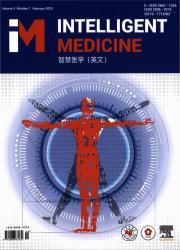A combined system with convolutional neural networks and transformers for automated quantification of left ventricular ejection fraction from 2D echocardiographic images
IF 6.9
Q1 COMPUTER SCIENCE, INTERDISCIPLINARY APPLICATIONS
引用次数: 0
Abstract
Background
Accurate measurement of left ventricular ejection fraction (LVEF) is crucial in diagnosing and managing cardiac conditions. Deep learning (DL) models offer potential to improve the consistency and efficiency of these measurements, reducing reliance on operator expertise.
Objective
The aim of this study was to develop an innovative software-hardware combined device, featuring a novel DL algorithm for the automated quantification of LVEF from 2D echocardiographic images.
Methods
A dataset of 2,113 patients admitted to the Affiliated Hospital of Qingdao University between January and June 2023 was assembled and split into training and test groups. Another 500 patients from another campus were prospectively collected as external validation group. The age, sex, reason for echocardiography and the type of patients were collected. Following standardized protocol training by senior echocardiographers using domestic ultrasound equipment, apical four-chamber view images were labeled manually and utilized for training our deep learning framework. This system combined convolutional neural networks (CNN) with transformers for enhanced image recognition and analysis. Combined with the model that was named QHAutoEF, a ‘one-touch’ software module was developed and integrated into the echocardiography hardware, providing intuitive, real-time visualization of LVEF measurements. The device's performance was evaluated with metrics such as the Dice coefficient and Jaccard index, along with computational efficiency indicators. The dice index, intersection over union, size, floating point operations per second and calculation time were used to compare the performance of our model with alternative deep learning architectures. Bland-Altman analysis and the receiver operating characteristic (ROC) curve were used for validation of the accuracy of the model. The scatter plot was used to evaluate the consistency of the manual and automated results among subgroups.
Results
Patients from external validation group were older than those from training group ((60±14) years vs. (55±16) years, respectively, P < 0.001). The gender distribution among three groups were showed no statistical difference (43 % vs. 42 % vs. 50 %, respectively, P = 0.095). Significant differences were showed among patients with different type (all P < 0.001) and reason for echocardiography (all P <0.001 except for other reasons). QHAutoEF achieved a high Dice index (0.942 at end-diastole, 0.917 at end-systole) with a notably compact model size (10.2 MB) and low computational cost (93.86 G floating point operations (FLOPs)). It exhibited high consistency with expert manual measurements (intraclass correlation coefficient (ICC) =0.90 (0.89, 0.92), P < 0.001) and excellent capability to differentiate patients with LVEF ≥60 % from those with reduced function, yielding an area under the operation curve (AUC) of 0.92 (0.90–0.95). Subgroup analysis showed a good correlation between QHAutoEF results and manual results from experienced experts among patients of different types (R = 0.93, 0.73, 0.92, respectively, P <0.001) and ages (R = 0.92, 0.94, 0.89, 0.91, 0.81, respectively, P <0.001).
Conclusions
Our software-hardware device offers an improved solution for the automated measurement of LVEF, demonstrating not only high accuracy and consistency with manual expert measurements but also practical adaptability for clinical settings. This device might potentially support clinicians and augment clinical decision.

基于卷积神经网络和变压器的二维超声心动图左心室射血分数自动定量分析系统
背景:准确测量左心室射血分数(LVEF)对于诊断和治疗心脏疾病至关重要。深度学习(DL)模型有可能提高这些测量的一致性和效率,减少对操作人员专业知识的依赖。目的本研究旨在开发一种创新的软硬件结合设备,该设备具有新颖的DL算法,可用于从二维超声心动图图像中自动量化LVEF。方法收集青岛大学附属医院2023年1 - 6月收治的2113例患者数据集,分为训练组和试验组。另外从另一校区前瞻性地收集500例患者作为外部验证组。收集患者的年龄、性别、超声心动图检查原因及类型。在高级超声心动图医师使用国产超声设备进行标准化协议培训后,人工标记根尖四室视图图像并用于训练我们的深度学习框架。该系统将卷积神经网络(CNN)与变压器相结合,以增强图像识别和分析。结合被命名为QHAutoEF的模型,一个“一键式”软件模块被开发并集成到超声心动图硬件中,提供直观、实时的LVEF测量可视化。该设备的性能通过Dice系数和Jaccard指数等指标以及计算效率指标进行评估。我们使用骰子索引、交集/联合、大小、每秒浮点操作数和计算时间来比较我们的模型与其他深度学习架构的性能。采用Bland-Altman分析和受试者工作特征(ROC)曲线对模型的准确性进行验证。散点图用于评估人工和自动结果在亚组之间的一致性。结果外部验证组患者比训练组患者年龄大((60±14)岁比(55±16)岁;0.001)。三组患者性别分布差异无统计学意义(分别为43%、42%、50%,P = 0.095)。不同类型患者间差异均有统计学意义(P <;0.001)和超声心动图的原因(除其他原因外,所有P <;0.001)。QHAutoEF获得了高Dice指数(舒张末期0.942,收缩期末期0.917),模型尺寸紧凑(10.2 MB),计算成本低(93.86 G浮点运算(FLOPs))。与专家手工测量结果具有较高的一致性(类内相关系数(ICC) =0.90 (0.89, 0.92), P <;0.001),并且具有出色的区分LVEF≥60%患者和功能降低患者的能力,手术曲线下面积(AUC)为0.92(0.90-0.95)。亚组分析显示,不同类型患者的QHAutoEF结果与经验丰富的专家手工结果(R分别为0.93、0.73、0.92,P <0.001)与年龄(R分别为0.92、0.94、0.89、0.91、0.81,P <0.001)具有良好的相关性。结论sour软-硬件设备为LVEF的自动测量提供了一种改进的解决方案,不仅具有较高的准确性和与人工专家测量的一致性,而且具有临床适应性。该设备可能潜在地支持临床医生并增强临床决策。
本文章由计算机程序翻译,如有差异,请以英文原文为准。
求助全文
约1分钟内获得全文
求助全文
来源期刊

Intelligent medicine
Surgery, Radiology and Imaging, Artificial Intelligence, Biomedical Engineering
CiteScore
5.20
自引率
0.00%
发文量
19
 求助内容:
求助内容: 应助结果提醒方式:
应助结果提醒方式:


